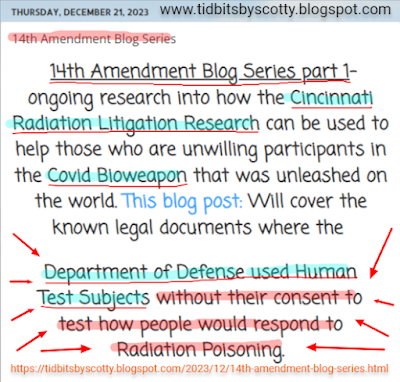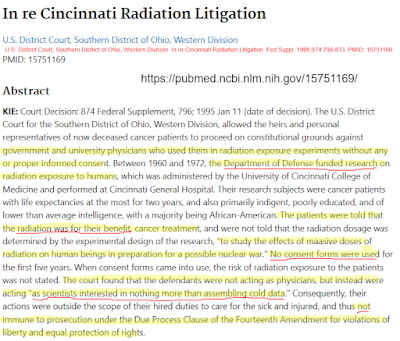14th Amendment Blog Series part 1- ongoing research into how the Cincinnati Radiation Litigation Research can be used to help those who are unwilling participants in the Covid Bioweapon that was unleashed on the world. This blog post: Will cover the known legal documents where the
Department of Defense used Human Test Subjects without their consent to test how people would respond to Radiation Poisoning.
Many of the the legal documents quoted here are from the Cincinnati Radiation Litigation court documents. U.S. District Court, Southern District of Ohio, Western Division. In re Cincinnati Radiation Litigation. Fed Suppl. 1995;874:796-833. PMID: 15751169 in addition to other court proceedings and legal schollars that have utilized the well established rules that set a precendence based on the established Constitutional Laws and Amendments.
All the images used in this blog post, twitter posts, and thread reader pdf below quote the souces used.
The Author states:
I cannot ignore the similarities of the well documented- though shrowded in secrecy how the Government Agencies performed the same tactics of the Human Radiation Experiements when comparing the current and ongoing Covid19 fiasco.
Intro in the 14th Amendment legalese quoted on National Institute of Health https://pubmed.ncbi.nlm.nih.gov/15751169/> #CincinnatiRadiationLitigation. > The Govt / Dept of Def experimented on people w/out consent> Hasn't the same thing been proven with the Covid19 Bioweapon???
The U.S. District Court for the Southern District of Ohio, Western Division, allowed the heirs and personal representatives of now deceased cancer patients to proceed on
- constitutional grounds against government and university physicians who used them in radiation exposure experiments without any or proper informed consent. Between 1960 and 1972,
- the Department of Defense funded research on radiation exposure to humans, which was administered by the University of Cincinnati College of Medicine and performed at Cincinnati General Hospital.
- Their research subjects were cancer patients with life expectancies at the most for two years, and also primarily indigent, poorly educated, and of lower than average intelligence, with a majority being African-American.
- The patients were told that the radiation was for their benefit, cancer treatment, and
- were not told that the radiation dosage was determined by the experimental design of the research, "to study the effects of maasive doses of radiation on human beings in preparation for a possible nuclear war."
- No consent forms were used for the first five years.
- When consent forms came into use, the risk of radiation exposure to the patients was not stated.
- The court found that the defendants were not acting as physicians, but instead were acting "as scientists interested in nothing more than assembling cold data."
- Consequently, their actions were outside the scope of their hired duties to care for the sick and injured, and thus not immune to prosecution under the Due Process Clause of the Fourteenth Amendment for violations of liberty and equal protection of rights.
I feel this is a viable course of holding the Govt accountable for their part in the covid bioweapon creation> legal preceedings of past actions against the Govt in re to the Dept of Defense that used humans for test subjects. #CincinnatiRadiaitonLitigation link
Maria Chappelle Naddal
The Cincinnati Radiation Experiments were a series of total and partial body irradiation tests performed on at least 90 patients with advanced cancer at the Cincinnati General Hospital, now University of Cincinnati Hospital, from 1960 to 1971. Led by radiologist Eugene L. Saenger, the experiments were funded in part by the Defense Atomic Support Agency within the Department of Defense to study how soldiers in nuclear war would be affected by large doses of radiation. The experiments were conducted without patient consent in the first five years of the study and with disputed levels of consent thereafter. The irradiated patients experienced nausea, vomiting, cognitive impairment, and death. The contract between the researchers and the DOD terminated in 1972 under pressure from Senator Edward Kennedy, marking the end of major human irradiation experimentation in the U.S. that began after World War II and continued throughout the Cold War Era.
Although initially fading from public eye, the controversy resurfaced in 1993 and was soon investigated by President Bill Clinton's Advisory Committee on Human Radiation Experiments. In 1994, families of the patients filed a class-action lawsuit against the team of 15 researchers. Five years later, the University of Cincinnati settled the case for over $4 million.
Department of Defense funding
On September 25, 1958, Saenger sent a grant proposal entitled "Metabolic Changes in Human following Total Body Radiation" to the Department of Defense, requesting $25,085 to analyze the amino-aciduria levels in the urine of total body irradiated patients. Although multiple military researchers, including the Director of the Division of Nuclear Medicine and Chemistry, wrote to the US Army Medical Research and Development Command that they doubted the practical value of Saenger's proposed study, the DOD approved the grant proposal due to its possibility of evaluating the combat effectiveness of soldiers in nuclear warfare. The initial grant proposal evolved into an 11-year contract, in which the DOD provided a total of $671,482.79 in funds. Detailing the progress of the experiment were a series of 10 progress reports sent to the DOD from 1960 to 1972, the first five of which were entitled "Metabolic Changes in Humans Following Total Body Irradiation" and the last five "Radiation Effects in Man: Manifestations and Therapeutic Efforts." The irradiation experiments only began after the DOD funding was received, with the first known experiment occurring on May 24, 1960.
There is controversy regarding how the DOD funds were allocated. Saenger maintained that while the DOD funds were used to buy irradiation equipment, run laboratory tests, and hire personnel, only University funds directly financed the patients' irradiation treatment. However, the Advisory Committee on Human Radiation Experiments held that without the DOD funds, Saenger could not have begun the irradiation tests.
Military purpose
As part of the DOD contract, the radiation experiments attempted to imitate nuclear wartime conditions in order to accurately evaluate the cognitive and physiological effects of radiation on a soldier. During irradiation, patients' bodies were positioned to mirror a soldier's defensive position; the radiation was intended, but not proven, to be administered unidirectionally to reflect a soldier's exposure; and the irradiation was administered all at once, which diverged from the standard medical practice at the time, where cancer patients were given small doses cumulatively to maximize destruction of cancer cells. Even so, in the progress reports sent to the DOD and in his testimony to the Subcommittee on Administrative Law and Governmental Relations in 1994, Saenger maintained that the primary goal of the study was to provide palliative and therapeutic care to the patients. According to Saenger, the study of radiation effects on a soldier's performance was a secondary goal.
Patient selection
The patients were referred to Dr. Saenger's experiments by the Cincinnati General Hospital's Tumor Clinic. All the patients had advanced stage cancers, including breast, lung, colon, pancreas, skin, sinus, ovarian, lymph, cervical, rectal, liver, stomach, esophagus, bowel, tongue, brain, tonsil, rectum, intestinal, and bone cancers. Although they were all cancerous, Saenger sought patients that were in good nutritional health, and who had not been exposed to previous radiation treatment.
The patient selection process was the subject of another controversy. David Egilman, a doctor practicing in Massachusetts at the time, criticized the patient selection and irradiation processes in a statement to the Advisory Committee on Human Radiation Experiments, writing that many of the cancers were radio-resistant and could not have been treated effectively without killing the patient. On the other hand, the American College of Radiology, after sending representatives to Saenger's laboratory during the irradiation experiments, concluded in a 1972 peer review that the patient selection process and the experiments as a whole "conformed with good medical practice."
Health effects
The experiments administered between 25 and 300 rad of Cobalt-60 total body and partial body irradiation, comparable to 20,000 chest x-rays, within hours. There were also plans to increase the radiation dosage to 600 rad. In addition, bone marrow was occasionally extracted prior to the irradiation and later reinfused in an effort to alleviate the debilitating health effects of the radiation.
The irradiated patients experienced a wide variety of side-effects: nausea, vomiting, diarrhea, emaciation, hemorrhaging, fatigue, cognitive impairment, and hallucinations. 1/4 of the patients died within 2 months of irradiation, and over 3/4 of the patients died within a year. In his testimony, Dr. Saenger maintained that assessing the direct contribution of the irradiation to the mortality rates is impossible due to the variety of health factors acting as confounding variables: prior chemotherapy treatment, localized radiation treatment, and the advanced stage cancer itself. He claimed that the cancer was the primary factor in the patients' deaths, and that the irradiation had palliative benefits for 31% of the patients.
Consent forms
From 1960 to 1965, no written consent forms were used in the experiments, in accordance with the requirements of the Cincinnati General Hospital; the Department of Health, Education, and Welfare; and the Department of Defense. In April 1965, the patients were given consent forms that, according to Dr. Saenger, appropriately discussed the dangers of the irradiation. However, David Egilman claimed that these forms did not mention any relevant side effects of the irradiation.
In 1969, the National Institutes of Health evaluated the Cincinnati General Hospital's ethical practices, prompting Saenger to adopt a new consent form outlining the purpose, procedure, and risks of the irradiation tests to the patients. Even so, no consent form used mentioned possible death.
During the 1994 trial, family members of the patients alleged that the researchers forged certain patients' signatures on the consent forms.
Researchers
- Dr. Eugene L. Saenger
- Dr. Edward B. Silberstein
- Dr. Bernard S. Aron
- Dr. Harry Horwitz
- Dr. James G. Kereiakes
- Dr. Harold Perry
- Dr. Ben I. Friedman
- Dr. Thomas Wright
- Dr. I-wen Chen
- Dr. Robert L. Kunkel
- Dr. Louis A. Gottschalk
- Dr. Theodore H. Wold
- Dr. Goldine Gleser
- Dr. Warren O. Kessler
- Dr. Myron I. Varon
.png) link to the file" />
link to the file" />Here is the Tweet Thread about Cincinnati Radiation Litigation
I am very proud to report that my blog is read by people from all over the World. Here is an image of the stats provided by blogger. https://t.co/qMKxgOh2X9 pic.twitter.com/04heGkQ6ZA
— Scotty (@StLHandyMan) December 21, 2023





.png)







No comments:
Post a Comment